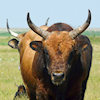Photos I made in the relatively young province of Flevoland. In the twentieth century half of the shallow sea Zuiderzee was reclaimed after this sea had been turned into a fresh water lake by the construction of an enormous dyke, the Afsluitdijk.
Foto’s gemaakt in de provincie Flevoland.
Former island Schokland
Schokland was one of the islands in the Zuiderzee. The island was abandoned in 1859. But when the land was reclaimed in 1942 farmers settled there again. Nowadays the elongated island is a Unesco international heritage site, with the old village of Middelbuurt turned into a museum.
Het eiland Schokland werd in 1859 ontruimd omdat de regering het er te gevaarlijk vond. Na de drooglegging van de Noordoostpolder vestigden zich weer boeren op het eiland. Tegenwoordig is Schokland volgens de Unesco internationaal erfgoed.
Art on the former island of Schokland (Dichter op het land) part 1 – June 2019
Dichter op het land: kunst op Schokland deel 1 – Juni 2019
Art on the former island of Schokland (Dichter op het land) part 2 – June 2019
Dichter op het land: kunst op Schokland deel 2 – Juni 2019
Art on the former island of Schokland (Dichter op het land) part 3 – June 2019
Dichter op het land: kunst op Schokland deel 3 – Juni 2019
Art on the former island of Schokland (Dichter op het water) august 2021
Dichter op het water: kunst op Schokland – augustus 2021
Horsterwold (Stille Kern)
The Horsterwold (wold=forest) is the largest forest in the Netherlands. Originally intended to be a production forest the central part – the heartland – is now a nature reserve. It is rather unique as it is the only forest on clay, which is by nature resitant to acid rain. At some time in the past the European Wisent was mentioned as an inhabitant, but nowadays we see Koniks, Deer and recently Highlanders.
Het Horsterwold is het grootste bos in ons land. Het was ooit bedoeld als productiebos, maar het centrale deel – de Stille Kern – is nu een natuurreservaat. Wat het Horsterwold uniek maakt is dat het op zeeklei ligt, van nature bestand tegen zure regen. Ooit is overwogen om de Europese Wisent hier te introduceren, maar tegenwoordig zien we alleen Konik paarden, herten en recent ook Schotse hooglanders.
High and low water levels in the Horsterwold heartland
Hoog en laag water in de Stille Kern
Storm damage and Highlanders in the Horsterwold heartland 2022
Stormschade en Schotse hooglanders in de Stille Kern
Hydrology Woods (Waterloopbos)
The Waterloopbos (Hydrology Woods) is situated in the reclaimed land called Noordoostpolder. The woods housed an open air laboratory since 1951, where engineers built scale models for several large water works projects in the Netherlands and for other countries. There was also a big long hall, the Deltahal, where enormous waves could be generated to test the Delta Works. In 1995 the laboratory was abandoned and largely forgotten, because testing could be done with computer simulation.
Het Waterloopbos ligt in de Noordoostpolder. In dit bos werden in de buitenlucht schaalmodellen gebouwd om stromingspatronen te onderzoeken van waterwerken die in ons land of elders in de wereld gebouwd moesten worden, ook de Deltawerken bijvoorbeeld. In een lange loods, de Deltahal, werden de golven opgewekt om de Oosterscheldekering te testen. In 1995 werd het laboratorium gesloten omdat het testen veel eenvoudiger ging met computersimulatie.
The discovery of the Dutch Hydrology Woods (Waterloopbos) 2008
De ontdekking van het Waterloopbos
Art in the Dutch Hydrology Woods (Waterloopbos – de Kielzog expositie) 2008
Kunst in het waterloopbos
Nature Reserve Oostvaardersplassen
Originally planned as industrial estate, economical changes led to another destination. People saw possibilities for a nature reserve with minimal interference, the “new wilderness” plan. The scheme collapsed under its own success: large herds of grazers had exhausted their own food sources and Dutch anti-nature groups demanded interference. Nowadays the Oostvaardersplassen are almost devoid of large animals.
Oorspronkelijk zou het Oostvaardersplassengebied een industriezone worden, maar daar had niemand belangstelling voor. Nadat het tijden braak had gelegen, was er een mooi natuurgebied ontstaan. Staatsbosbeheer wilde proberen of het gebied met grote grazers zichzelf kon reguleren, maar al snel was het gebied kaalgevreten. Boze anti-natuur elementen eisten regulering. Met het gevolg dat het nu een beetje saai gebied is.
The Dutch Serengetti in 2015
De Oostvaardersplassen in 2015









